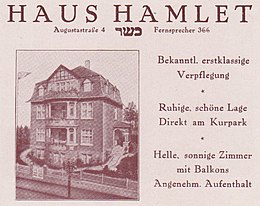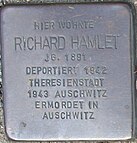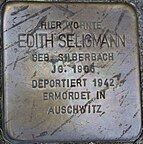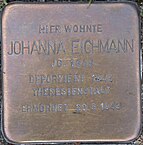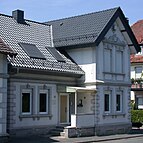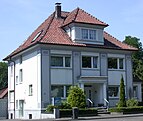List of stumbling blocks in Bad Salzuflen
The Stolpersteine in Bad Salzuflen are special paving stones in sidewalks that are intended to commemorate the victims of the National Socialist dictatorship in the East Westphalian city of Bad Salzuflen in the North Rhine-Westphalian district of Lippe in Germany .
Stumbling blocks
The Stolpersteine are a project by the artist Gunter Demnig . These small memorial plaques are intended to commemorate the fate of the people who were murdered, deported , expelled or driven to suicide during National Socialism .
The stumbling blocks are cubic concrete blocks with an edge length of ten centimeters, on the top of which there is an individually labeled brass plate . As a rule, they are set into the pavement at the same level in front of the last freely chosen houses of the Nazi victims . There are now over 53,000 stones (as of June 2015) not only in Germany, but also in 18 other European countries. The Stolpersteine are the largest decentralized memorial in the world.
Decision for Bad Salzuflen
After various debates and discussions, the Bad Salzufler City Council voted on February 3, 2010 with a large majority in favor of this kind of remembrance of the victims of the Nazis:
- “The city of Bad Salzuflen is participating in the Stolpersteine project developed by the artist Gunter Demnig from Cologne. To commemorate the Jewish men, women and children from Bad Salzuflen and Schötmar who were victims of persecution during the Nazi era, a stumbling block should be placed on the sidewalk in front of the last freely chosen place of residence. The implementation of the action is entrusted to the Bad Salzufler advice, which is supported by the city archive. The project is financed exclusively through sponsors who are recruited by the Bad Salzufler advice. "
The advice against xenophobia had initiated the action and, as a result of the council decision, advertised the adoption of sponsorships that were together in May. “Memory needs a place,” said Mayor Dr. Wolfgang Honsdorf and put the stumbling blocks in a row with the plaque and the memorial on Mauerstrasse or the commemoration of the pogrom night on November 9th.
In November 2010 in Salzuflen and in early December 2011 in the Schötmar district, Gunter Demnig laid a total of more than sixty stumbling blocks.
Laying stumbling blocks in Salzuflen
At the market 22
Here lived Kurt Anderman (* 1919), one of the sons of the merchant family the other man who led a 1913 founded hat shop here. Even Prince Leopold IV of Lippe bought hats from the Andermann fashion house . Kurt Andermann fled to Czechoslovakia in 1937 , was deported to Theresienstadt in 1942 and murdered in Bergen-Belsen on March 20, 1944 .
LIVED HERE / KURT ANDERMANN / JG. 1919 / FLUCHT 1937 CSR / DEPORTIERT 1942 / THERESIENSTADT / MURDERED 20.3.1944 / BERGEN-BELSEN
Augustastraße 4
Coordinates “Augustastraße 4”
The seven stumbling blocks laid here are reminiscent ofRebekka Berger(* 1858; néeHolländer),Richard(* 1891) andLina Hamlet(* 1889; néeBerger), owners ofthe Hamlet family, as well asGünther,Herbert,MaxandWerner Stamm,who were murderedinAuschwitzand Theresienstadt, respectively.
LIVED HERE / REBEKKA BERGER / GEB. DUTCHMAN / JG. 1858 / DEPORTED 1942 / THERESIENSTADT / MURDERED 12/10/1942 LIVED
HERE / LINA HAMLET / BED. BERGER / JG. 1889 / DEPORTED 1942 / THERESIENSTADT / 1943 AUSCHWITZ / MURDERED IN / AUSCHWITZ LIVED
HERE / RICHARD HAMLET / JG. 1891 / DEPORTED 1942 / THERESIENSTADT / 1943 AUSCHWITZ / MURDERED IN / AUSCHWITZ LIVED
HERE / GÜNTHER STEM / JG. 1920 / DEPORTED 1943 / MURDERED IN / AUSCHWITZ LIVED
HERE / HERBERT STAMM / JG. 1924 / DEPORTED 1942 / MURDERED IN / AUSCHWITZ LIVED
HERE / MAX STAMM / JG. 1892 / DEPORTED 1943 / MURDERED IN / AUSCHWITZ LIVED
HERE / WERNER STAMM / JG. 1922 / DEPORTED 1943 / AUSCHWITZ / MURDERED 2.1.1944
Beetstrasse 11
Siegfried Klarbach (* 1872) lived in house no.11 . He was deported to Theresienstadt in 1942 and murdered there on September 2 of the same year.
Brüderstrasse 26
Siegfried Obermeyer (* 1883), Amalia (* 1895 in Münster ; née Scheiberg ) and Ernst (* 1920) came from one of the most respected families in the city until 1933, who since 1900 had a household and hardware store founded in 1858 in Lange Straße 39 / 41 operated. The three-storey half-timbered building, erected in 1618, with two storeys, four projections and rich rosette decorations, characterizes the Salzufler cityscape along with many other buildings of this type. In addition to his business activities, Siegfried was the last head of the Jewish synagogue community in Bad Salzuflens. The closure of the Obermeyer household goods store was ordered on November 12, 1938 at the end of the year. Only then did the family decide to leave Germany. They were arrested in Luxembourg in 1940 while they were fleeing, mother and father were murdered in the Lodz ghetto and Ernst in the Auschwitz extermination camp. Only son Hans (John) (* 1928) survived: he traveled with one of the last “Kindertransporte” in 1939 from Bad Salzuflen to England and later to New York in the United States. - He financed the three stumbling blocks for his parents and his brother.
Ida Stern (* 1890) was the housemaid of the Jewish Obermeyer family. She was murdered in Sobibor.
Long Street 11
Here, on the southern edge of the Salzhof, was the 'Tellmann / Reker' house, built in 1512, where Jenny Katzenstein (* 1883) once lived. She was later deported to Auschwitz and murdered there.
LIVED HERE / JENNY / KATZENSTEIN / JG. 1883 / DEPORTED / AUSCHWITZ / MURDERED
Obere Mühlenstrasse 8
Coordinates "Obere Mühlenstraße 8"
David (* 1882) and Julie Berghausen (* 1867; née Hecht ) were among the last five Jews still living in Salzuflen , along with Elise Hecht and Richard and Lina Hamlet.
David and Julie Berghausen were deported to Theresienstadt in 1942 and murdered there, David on January 22, 1943, his wife on June 7, 1944.
Anna Stern (* ~ 1905, née Blumenthal ), who moved from Rehburg , lived only three weeks in Bad Salzuflen in 1939, first in Obere Mühlenstrasse, then in Langen Strasse 41. She later lived in Ratibor in Silesia ; from here she was deported to Auschwitz and murdered there. - The evangelical-reformed parish of Bad Salzuflen has taken over the sponsorship for the “Stolperstein Anna Stern”.
Roonstrasse 46
Erna Spanner (* 1892; nee Lipper ) and Frieda Vorreuter (* 1885) lived in house number 46 . Erna Spanner was deported to Auschwitz in 1942 and murdered there; Frieda Vorreuter was transported to Theresienstadt and murdered there on August 19, 1942.
LIVED HERE / ERNA SPANNER / GEB. LIPPER / JG. 1892 / DEPORTED 1942 / MURDERED IN / AUSCHWITZ
LIVED HERE / FRIEDA VORREUTER / JG. 1885 / DEPORTED 1942 / THERESIENSTADT / MURDERED August 19, 1942
Wenkenstrasse 2
The Aschenbrand family lived here from 1933 to 1935: the merchant Julius Aschenbrand , his wife Bertha (* in Herford; née Hecht ) and their son Gerd Adolf (born March 1, 1935 in Schötmar). Julius, originally from Frankfurt, emigrated to the Netherlands in 1935, was deported to the Westerbork internment camp there in 1942 and from there to Theresienstadt in 1944. His wife Bertha moved back to Herford to live with her family after her husband left. She survived the Holocaust and applied for redress in 1956. Her son also survived the Holocaust.
Wenkenstrasse 5
The couple Max and Selma Kornberg had to move to the “Judenhaus Lange Straße 41” (Obermeyer) in September 1939 due to the “ Law on Tenancy with Jews ”. From there they were deported on March 31, 1942 via Bielefeld to the Warsaw ghetto. Selma Kornberg died in the Treblinka concentration camp, her husband Max was murdered on November 3, 1943 in Trawniki near Lubin. Their son Hans (born January 14, 1928) was able to emigrate by train to his uncle in Yorkshire in Great Britain four days before his eleventh birthday .
Stumbling blocks laid in Schötmar
Begastrasse 22
The Silberbach family lived in this house: the cattle dealer Salomon Silberbach (* 1875 in Schötmar), his wife Rosa (* 1886 in Achim ; née Anspacher ) and their daughter Hildegard (* 1912; married van der Wijk ). Salomon ran a cattle shop in the house, which was founded in 1911 by his father Herz Silberbach (1844–1921). Due to the ongoing agitation of the National Socialists against Jewish traders, the customers stayed away, so that the once flourishing business had to be closed on June 27, 1938. Eight months later, on February 21, 1939, Salomon and Rosa Silberbach fled to The Hague in the Netherlands, which had been occupied by the German Wehrmacht since 1940 . At the behest of the Gestapo , the Silberbach couple were stripped of their German citizenship on January 7, 1941. On January 26, 1943, the now stateless Salomon and Rosa were deported to the Westerbork transit camp . From there, on April 13, 1943, she was deported to the Sobibor extermination camp . Three days later, Salomon and Rosa Silberbach were murdered there. The daughter Hildegard, who had fled to the Netherlands on June 10, 1938, was also deported to Sobibor together with her husband Siegfried. She was murdered there on June 4, 1943, her husband three days later.
LIVED HERE / SALOMON / SILBERBACH / JG. 1875 / ESCAPE 1939 HOLLAND / INTERNIERT WESTERBORK / DEPORTED 1943 / SOBIBOR / MURDERED 04/16/1943
LIVED HERE / ROSA SILBERBACH / GEB. ANSPACHER / JG 1886 / FLUCHT 1939 HOLLAND / INTERNIERT WESTERBORK / DEPORTED 1943 / SOBIBOR / MURDERED April 16, 1943
LIVED HERE / HILDEGARD / VAN DER WIJK / GEB. SILBERBACH / JG. 1912 / ESCAPE 1938 HOLLAND / Interned / DEPORTED / SOBIBOR / MURDERED 4.6.1943
Even Martha Hünerberg (* 1884 in Achim; born Anspacher ) - the older sister of Rosa Silver Creek - and her son Kurt (* 1924) lived in this house. The widow and her son moved from Neustadt am Rübenberge on November 18, 1938 . Both lived under one roof with their relatives for only a few months. On April 18, 1939, they moved to Hanover . From there, Martha and Kurt Hünerberg were deported to the Warsaw ghetto on March 31, 1942 . Martha Hünerberg was murdered in the ghetto; Kurt Hünerberg was deported from Warsaw to the Treblinka extermination camp , where he was also murdered.
LIVED HERE / MARTHA HÜHNERBERG / GEB. ANSPACHER / JG. 1884 / DEPORTED 1942 / MURDERED IN / GHETTO WARSAW
LIVED HERE / KURT HÜNERBERG / JG. 1924 / DEPORTED 1942 / GHETTO WARSAW / MURDERED IN / TREBLINKA
Anna Block (* 1885 in Petershagen ) was one of the residents of the house from May to August 1938. The single housemaid, who had previously lived in Herford, moved to Minden on August 31, 1938 and was deported from Bielefeld to the Riga ghetto in December 1941, where she was murdered.
LIVED HERE / ANNA BLOCK / JG. 1885 / DEPORTED 1941 / MURDERED IN / RIGA
Edith Seligmann (* 1906; née Silberbach ), who was born in Schötmar , was also one of the residents of house number 22. She was a grand cousin of the house owner Salomon Silberbach and had already lost her husband Werner Seligmann in an accident at a young age. Edith was deported via Bielefeld to the Auschwitz concentration camp on July 8, 1942, and murdered there.
LIVED HERE / EDITH SELIGMANN / GEB. SILBERBACH / JG. 1906 / DEPORTED 1942 / MURDERED IN / AUSCHWITZ
Eduard-Wolff-Strasse 5
Coordinates "Eduard-Wolff-Straße 5"
The widow Meta Schneider (* 1891; née Nordhäuser ), who had moved from Cologne, lived in Eduard-Wolff-Strasse, which was still known as Bahnhofstrasse during the Nazi era , since December 15, 1937 . She earned her living as a housekeeper for the former cattle dealer Julius Silberbach. When he moved to Emden in June 1939 , Meta Schneider moved to Bad Oeynhausen . She was later abducted to one of the camps in the east, where she was most likely murdered.
LIVED HERE / META SCHNEIDER / GEB. NORDHÄUSER / JG. 1891 / DEPORTED / ???
Schlossstrasse 16
Henny (* 1868 in Schötmar), Ida (* 1869 in Bolzum ; née Güdemann ) and Max Rosenwald (* 1870 in Schötmar) lived here on Schloßstraße - formerly Hindenburgstraße . In the previous building of today's house, the Rosenwalds ran a household goods store, which was founded in 1904 by Ida's husband, Hermann Rosenwald (born January 22, 1863, † June 10, 1939, buried in the cemetery on Oerlinghauser Strasse). At the urging of the Nazis, the Rosenwalds had to close their shop at the end of 1938. Henny, Ida and Max Rosenwald were probably deported from Bielefeld to the Theresienstadt concentration camp on July 31, 1942; from there they were moved to the Maly Trostinez extermination camp near Minsk and murdered there. The date of her death is unknown.
Even Hans Eichmann (* 1894) and his in Barntrup born wife Gertrude (* 1902; born Katz ) lived in house No. 16. Hans Eichmann worked as a cattle dealer.. The business of his cattle dealer, founded in 1932, was very sluggish due to the systematic exclusion of the Jewish population. In the summer of 1937 he had to close his cattle shop and from then on worked for his brother Bruno (* 1900). On the morning of November 10, 1938, Hans Eichmann was arrested along with six other men from the Schötmar Jewish community and deported for several weeks to the Buchenwald concentration camp, from which he was released on December 12, 1938. Three years later, on December 13, 1941, Hans Eichmann was deported from Bielefeld to the Riga ghetto and murdered there. Gertrud was deported to the Ravensbrück concentration camp in spring 1942 and murdered there on April 3, 1942. Their daughter Susanne (* 1926) escaped with her cousin on August 11, 1939 on a Kindertransport to Birmingham . She lived in South Africa since the 1950s .
Ilse Eichmann (* 1902; nee Strauss ) and her husband Bruno had been living as sub-tenants in Gertrud and Hans Eichmann's apartment since the summer of 1939. Bruno had also been a self-employed cattle dealer since 1925. During the pogrom, on the morning of November 10, 1938, he was arrested and held in Buchenwald concentration camp until December 12 . Shortly after his release, he was banned from working: on the instructions of the authorities, he had to close his cattle shop. Bruno and Ilse Eichmann were deported from Bielefeld to the Riga ghetto on December 13, 1941. While Ilse was killed there, Bruno was transferred to the Stutthof concentration camp near Danzig on October 1, 1944 . He was probably murdered there. Her daughter Ursula (* 1924) fled to Birmingham; she stayed in Great Britain and later raised a family there.
Ella Silberbach (* 1886) and her daughter Margret (* 1930) also lived in house No. 16. Ella earned a living as a housemaid, so she lived in modest circumstances. They too were deported from Bielefeld to the Riga ghetto on December 13, 1941, and murdered there; the exact date of her death is not known.
Schülerstrasse 18
Coordinates "Schülerstrasse 18"
The widow Alma Silberbach (* 1869 in Eldagsen ; née Mannheim ) and her daughter Herta (* 1906 in Schötmar) lived in house number 18 in the former Schlageterstrasse . Alma ran the butcher shop of her deceased husband Julius (* July 31, 1873, † September 30, 1929, buried in the cemetery on Oerlinghauser Strasse) in the house of her father-in-law, butcher Salomon Silberbach. On the instructions of the Nazi authorities, she had to close her shop on December 31, 1938. The 35-year-old Herta Silberbach was taken by train to Bad Salzuflen on March 30, 1942 and from there with Salzufler Jews via Bielefeld to the Warsaw ghetto, where she was murdered. Her mother Alma was deported to the Theresienstadt concentration camp via Bielefeld on the same day. From there she was deported to the Maly Trostenez extermination camp near Minsk, where she was murdered. The date of her death is unknown.
Agricultural worker Isaak Weinberg (* 1885 in Silixen ) also lived in house number 18. Due to health problems, he left Schötmar and moved to a Jewish retirement home in Berlin-Weißensee on September 29, 1939 . It is very likely that he was abducted from there to one of the concentration camps and murdered.
LIVED HERE / ISAAK WEINBERG / JG. 1885 / DEPORTED / DESTINATION UNKNOWN / ???
Schülerstrasse 20
Coordinates "Schülerstrasse 20"
This house originally also belonged to the Silberbach family. Julius Silberbach's sister, Berta Wallhausen (* 1877 in Schötmar), her husband, the butcher Moritz (* 1881), their son Günther (* 1920) and Julie Sella Silberbach (* 1879), a younger sister of Berta Wallhausen, lived here. The butcher's shop, which opened in 1920, had to close at the end of 1938 due to an official order.
On December 13, 1941, the Wallhausen couple and Julie Sella Silberbach were deported to the Riga ghetto via Bielefeld and later murdered there. Only Günther Wallhausen survived the period of suffering in the concentration camps: after an odyssey through several camps, the last stop was the Stutthof concentration camp near Danzig, he emigrated to Sweden in May 1945 , where he married a Polish-born Jew. With her he later moved to Sydney , Australia ; he died there in 1967, at the age of only 47.
LIVED HERE / BERTA / WALLHAUSEN / GEB. SILBERBACH / JG. 1877 / DEPORTED 1941 / RIGA / MURDERED
LIVED HERE / MORITZ / WALLHAUSEN / JG. 1881 / DEPORTED 1941 / RIGA / MURDERED
LIVED HERE / JULIE SELLA / SILBERBACH / JG. 1879 / DEPORTED 1941 / RIGA / MURDERED
Johanna Eichmann (* 1869 in Essen ) also lived for a few months in house number 20. She moved from Bad Salzuflen on October 3, 1938, but left Schötmar on April 20, 1939 for Bielefeld to a Jewish retirement home in the Stapenhorststrasse. On July 31, 1942, she was deported to the Theresienstadt concentration camp and murdered there on June 20, 1943.
LIVED HERE / JOHANNA EICHMANN / JG. 1869 / DEPORTED 1942 / THERESIENSTADT / MURDERED June 20, 1943
Schülerstrasse 22
Coordinates "Schülerstrasse 22"
Berta (* 1899), Else (* 1896), Hedwig (* 1892) and her twin brother Paul Hamlet (* 1892) were the four children of the merchant Max Hamlet born in Schötmar. In the mid-1920s, Paul took over his father's cattle business, which he had founded in 1911 and which he had to give up at the end of 1938 on official orders.
Paul, whose wife Anna (née Blum ) died in June 1942 in a Jewish hospital in Hanover, was deported from Bielefeld to Theresienstadt on July 31, 1942. From there he was transferred to the Auschwitz extermination camp on January 29, 1943, along with 1,000 other Jews, where he was murdered.
In 1934 Hedwig had founded a soap shop with an attached mail order business in house number 22, which was also forcibly closed at the end of 1938. She was deported from Bielefeld to the Riga ghetto on December 13, 1941, together with her unmarried sisters Berta and Else. Hedwig and Else Hamlet were murdered there. Berta Hamlet, who had worked as a housemaid in numerous Jewish families since the early 1920s, was deported from Riga to the Stutthof concentration camp on August 9, 1944, where she was also murdered.
LIVED HERE / BERTA HAMLET / JG. 1899 / DEPORTED 1941 / RIGA / MURDERED IN / STUTTHOF
LIVED HERE / ELSE HAMLET / JG. 1896 / DEPORTED 1941 / RIGA / MURDERED
LIVED HERE / HEDWIG HAMLET / JG. 1892 / DEPORTED 1941 / RIGA / MURDERED
LIVED HERE / PAUL HAMLET / JG. 1892 / DEPORTED 1942 / THERESIENSTADT / MURDERED IN / AUSCHWITZ>
The Grünewald family - Meinhard (* 1878 in Oerlinghausen ), his wife Sofie (* in Rotenburg an der Fulda ; née Rotschild ) and their son Fritz (* 1905) - were among the residents of house No. 22. Meinhard was A successful businessman: Together with Richard Silberbach, he founded a small celluloid and plait holder factory in Krumme Weide 47 in Schötmar in 1934, which temporarily employed up to nine men and women. The company had to be closed at the end of 1938 by order of the authorities.
Meinhard, Sofie and Fritz Grünewald were deported to Auschwitz via Bielefeld on July 8, 1942. Fritz had the prisoner number 78618 there. The entire family was murdered in the extermination camp; the dates of their death are not known.
HER LIVED / MEINHARD / GRÜNEWALD / JG. 1878 / DEPORTED 1942 / MURDERED IN / AUSCHWITZ
LIVED HERE / SOFIE GRÜNEWALD / GEB. ROTSCHILD / JG. 1881 / DEPORTED 1942 / MURDERED IN / AUSCHWITZ
LIVED HERE / FRITZ GRÜNEWALD / JG. 1905 / DEPORTED 1942 / MURDERED IN / AUSCHWITZ
Schülerstrasse 23
Coordinates "Schülerstrasse 23"
Michael Fürst , a leather merchant who was born in Poland in 1895, had lived in house number 23 since 1924. In 1935 he fled to Belgium. There he was arrested by German troops in 1940 and taken back to Lippe. On January 29, 1941, the Detmold District Court sentenced him to a prison term of eighteen months for an alleged foreign exchange offense. After his release on May 23, 1942, he was deported to the Theresienstadt concentration camp and murdered there.
The Bergkirchen parish has taken on the sponsorship of the “Stolperstein Michael Fürst”.
LIVED HERE / MICHAEL FÜRST / JG. 1895 / ESCAPE 1935 BELGIUM / ARRESTED 1941 / AMTSGERICHTSGEPÄNGNIS / DETMOLD / DEPORTED 1942 / THERESIENSTADT / MURDERED
Schülerstrasse 29
Coordinates "Schülerstrasse 29"
The cattle dealer Julius Silberbach (* 1868 in Schötmar) lived here with his wife Pauline, who was born in Linz on the Rhine (* around 1871; † 1930 in Schötmar, buried in the Jewish cemetery on Oerlinghauser Strasse; née Goldschmidt ). Julius Silberbach gave up his cattle business, which had been founded shortly after the turn of the century, in December 1935 for health reasons. On June 14, 1939, the widower moved to Emden in an Israelite retirement home. From there he was deported to Theresienstadt in 1942, where he was murdered.
JULIUS SILBERBACH LIVED HERE / JG. 1868 / DEPORTED 1942 / THERESIENSTADT / MURDERED 12/14/1942
Vehrlingstrasse 18
Coordinates "Vehrlingstraße 18"
The widow Berta Cohen (born February 12, 1866 in Schötmar; née Silberbach ) had lived here on Vehrlingstrasse, formerly known as Gartenstrasse , since the mid-1920s . Her husband, the butcher Nathan Cohen (born February 14, 1871), who died on July 6, 1924 in Schötmar , was buried in the cemetery on Oerlinghauser Strasse. Berta Cohen moved to Berlin at the beginning of September 1939. From there she was deported to the Theresienstadt concentration camp on May 28, 1943, where she was murdered on April 13, 1945.
literature
- Franz Meyer (Ed.): Bad Salzuflen - Epochs of City History . Publishing house for regional history, Bielefeld 2007, ISBN 978-3-89534-606-4 .
- Franz Meyer for Bad Salzuflen City Archives (Ed.): Traces of Jewish Life - City Tours in Bad Salzuflen and Schötmar; Volume 7 of the "Contributions to the History of the City of Bad Salzuflen" . 1st edition. Publishing house of the Heimat- und Beautification Association Bad Salzuflen e. V., Bad Salzuflen 2010, ISBN 978-3-941726-11-6 .
- Joachim Rönneper : On my doorstep. “Stumbling blocks” by Gunter Demnig. A companion book . Arachne-Verlag, Gelsenkirchen 2010, ISBN 978-3-932005-40-4 .
Web links
- Gunter Demnig's website for the "Stolpersteine" project
- "Stumbling blocks" at MBK - Evangelisches Jugend- und Missionswerk e. V. ( Memento from November 25, 2012 in the Internet Archive )
- “Stumbling blocks” in Schötmar remind of Nazi victims in the Lippische Landeszeitung
- Stumbling blocks in Schötmar at www.salzstreuner.de
- Laying of stumbling blocks for the victims of the Holocaust in Schötmar at www.lippeblatt.de ( Memento from July 20, 2013 in the web archive archive.today )
Individual evidence
- ↑ In #Turin (Italy) the 50,000th #Stolperstein in Europe was laid today! He is reminiscent of Eleonora Levi. #Demnig @_Stolpersteine_ on January 11, 2015 on Twitter.
- ↑ Andreas Nefzger: The trace layer. In: FAZ.net . February 7, 2014, accessed December 16, 2014 .
- ↑ "Stumbling blocks - why or why not?" At www.lippe-aktuell.de
- ^ Statement by the Bad Salzuflen Home and Improvement Association (HVV) on the "Stolpersteine" campaign of December 30, 2009 (letter to the mayor and the city council of Bad Salzuflen)
- ↑ The majority of the council votes in favor of laying the “stumbling blocks” / Preserving memories in a new way in Lippe currently on February 10, 2010
- ↑ J. Eder: The way of remembrance at HBM1.DE ( Memento of the original from February 24, 2016 in the Internet Archive ) Info: The archive link was inserted automatically and has not yet been checked. Please check the original and archive link according to the instructions and then remove this notice.
- ^ Chronicle on the website of the artist Gunter Demnig
- ↑ Stolpersteine in Schötmar at the Ev.-ref. Parish of Schötmar
- ↑ Jewish couple in 1940 deported to Lodz at www.hiergeblieben.de
- ↑ DER GMEINDEBRIEF - magazine of the evangelical-reformed church community Bad Salzuflen. No. 219, October / November 2010 (PDF; 1.2 MB)
- ↑ Bertha Aschenbrand survived the Holocaust in the Lippische Landeszeitung (LZ.de) on January 10, 2011
- ↑ United States Holocaust Memorial Museum: ADOLF GERD ASCHENBRAND
- ↑ One of the last contemporary witnesses at 'Lippe aktuell'
- ↑ The Jewish cemetery in Schötmar at www.nhv-ahnenforschung.de (PDF; 7.1 MB)
- ^ Andreas Ruppert: The Warsaw Ghetto and Detmold. In: Rosenland. Journal of Lippe History. No. 4, 2006, pages 2… 17
- ↑ C. Wentz: Bergkirchen supports the "Stolpersteine" campaign. In: CONTACTS - Community letter of the parishes Bergkirchen and Retzen. No. 122, October / November 2010 (PDF; 5.4 MB)

